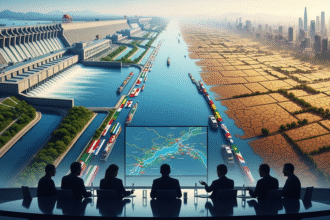With increasing warming of the planet, the migration of populations due to the influence of environmental change is not anymore a hypothetical prediction; it becomes a current fact. Millions are being uprooted by rising seas, extended droughts, hurricanes, and changing ecosystems. However, with increasing magnitude of climate migration, there has been failure to match the international and national legal frameworks. Lack of well-defined regulations exposes the affected persons to vulnerability and governments are unsure of their responsibility. The urgent 21 st century challenge is to fill these legal loopholes with new policy solutions.
Migration in Climate vs. Traditional Categories.
Migration is not new, climate change provides a disruptive force to old patterns. According to estimates of the International Organization of Migration among environmental factors, tens of millions of people may be displaced each year by mid-century. This covers both the rapid disaster (e.g. hurricanes and floods) and gradual changes (e.g. desertification or sea-level rise).
Laws have it though that people who have been displaced by climatic forces are usually left in between. The 1951 refugee convention safeguards refugees who are fleeing persecution due to the reason(s) that include race, religion, nationality, belonging to a specific social group or political opinion. It excludes individuals who have been displaced by environmental damage without an association with persecution. Others are also internally displaced in their respective countries whereby international refugee law is not applicable.
The Intensity and Complicated Character of Climate-induced Mobility.
Climate migration is hardly a one-factor occurrence. There is interaction of environmental stress, poverty, governance failures, and conflict, to formulate choices to move. Other individuals cross the borders; a larger number of the population moves in and out or temporarily immigrates. Such complexity provokes policymakers, who would like to classify and enumerate so-called climate migrants.
Small island countries that are experiencing existential risks due to rise of sea level help to demonstrate the ineffectiveness of existing frameworks. The people of Tuvalu, Kiribati, or the Maldives can become stateless because of the climate change, but the status of statelessness due to the climate change is not recognized by the law. In like manner, displaced drought victims in the Sahel or the Central American countries usually relocate without any security under the laws of refugees or labor.
Loopholes in International Legal Framework.
The key legal gaps include:
- No special status: There is no international treaty on climate refugee. Current refugee laws and the regimes of complementary protection are limited to special situations.
- Absence of the protection across boundaries: Majority of people displaced by disasters are not legally able to enter or continue staying in a different nation unless they are eligible to other visas.
- Minor rights to relocate: States facing the threat of sea-level rise do not have any entitlement to a joint relocation, or to hold on to maritime rights in the event of loss of territory.
- Poor internal defense: National disaster recovery and social safety nets are usually ineffective even when citizens stay on their territory.
Sometimes regional instruments even further. Internal displacement occasioned by natural disasters are covered under the Kampala Convention of the African Union. The Organization of American States has realized the connection between climate change and displacement. Yet these are intermittent and ad hoc around the world.
New Policy Ideas.
With these gaps, there is movement towards more flexible and humane responses. Some of the approaches are:
- Protective and humanitarian visas. Others are countries that give people with disasters temporary status so that they are unable to get home. One example of this is the Temporary Protected Status (TPS) used by the U.S. on the nationals of countries hit by hurricanes. The increase in such schemes and harmonization would offer some breathing space to the affected populations.
- Labor migration routes. Establishing legal labor channels to individuals in climate-prone areas will alleviate irregular migration and advantage the economies that receive them. New Zealand experimented with quotas of pacific islanders some of which take into account specifically environmental vulnerability.
- Planned relocation. In case of slow changes in occurrence, governments can collaborate with communities to arrange voluntary migration prior to disaster occurrence. Fiji has started to relocate villages at risk of being overtopped by the sea on a nationwide approach.
- Regional compacts. Neighbors are able to bargain on burden sharing and mutual support. A model of cooperation could be seen in the Comprehensive Regional Protection and Solutions Framework (MIRPS) in Central America although, in this case, it concerns the displacement caused by violence.
- Risk-sharing and insurance. Both adaptation and post-disaster mobility can be funded by innovative financing like climate risk insurance or loss-and-damage funds as part of the UNFCCC.
Incorporating Climate Mobility into Global Processes.
The 2018 Global Compact for Safe, Orderly and Regular Migration (GCM) is the first significant international tool to acknowledge climate change as a factor in migration. Even though not binding, it helps states to create policies regarding disaster displacement, planned relocation, and visa pathways. Best practices are also encouraged by the Platform on Disaster Displacement and by Nansen Initiative.
Within the context of the Paris Agreement, the adaptation plans may also encompass the measures that are connected to the human mobility. Relocation or protection has a chance of financing with the new Loss and Damage Fund agreed at COP27. But these mechanisms are still at their infancy and have no specific mandate or funds on migration.
Human Rights and national Responsibilities.
Finally, states have the first line of responsibility to ensure the security of people on its land. Forced displacement can be minimized by enhancing national disaster preparedness, social protection, and internal relocation structures. It is vital to ensure that internally displaced persons can gain access to houses, health care and livelihood.
The human rights law offers certain minimum protection irrespective of legal status. The UN Human Rights Committee petitioned in 2020 that it may be against the right to life to take people back to life-threatening climatic circumstances. This may slowly affect the way states evaluate the cases of asylum or deportation based on climate issues.
Implementation Problems.
Even diverse policies that are developed successfully have to encounter political and practical barriers. States receiving are concerned about the establishment of precedents that lead to high inflows. Countries that are already within developing nations and are already receiving the displaced might not be resourceful. The areas to be relocated might not want to move or lose their culture when they are resettled.
Planning is also frustrating because of data limitations. A lot of climate refugee projections are speculative, and it is difficult to develop quotas or programs. Also, migration is not the only possible way of adapting to changes; individuals can be encouraged to remain where they are provided with resilience support.
Towards a Holistic approach.
Considering all these complications, there will be no individual treaty that will resolve the climate movement in one day. Rather, this requires a multi-layered approach:
- Extend and reconcile ad hoc protection into people who have been displaced by disasters and gradual change.
- Produce frequent migration routes that are associated with adaptation funding of vulnerable areas.
- Make national and regional strategies on intended relocation, including community involvement and protection of human rights.
- Make climate mobility a part of climate finance, adaptation plans and development planning.
- Gather superior information about the movement because of climate changes to make evidence-based policies.
This is based on the acknowledgment of mobility as an aspect of adaptation and not a crisis to be contained. Properly managed migration may lead to reduction of vulnerability, diversification of risk and facilitating growth to both sending and receiving communities.
Conclusion
Migration due to climate change is among the characteristic humanitarian and governance challenges of the present day. Millions of people face the risk of being left unprotected and displaced without a policy innovation and without any legal recognition. But the migration of people as a result of environmental change does not have to be all about loss. When tackled proactively, it can be used as a source of resilience and mutual prosperity. Addressing the legal gaps needs to be an issue of political will, resources, and mindset reconsideration, no longer as a result of climate-driven mobility being an anomaly, but rather as a foreseeable and regulated element in the global reaction to climate change. There is a limited amount of time to act, yet, with a vision and cooperation, states will be able to develop solutions that will support human dignity in the context of a warming world.









